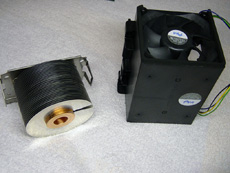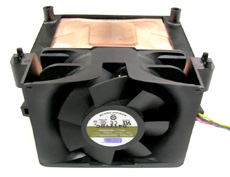Intel's Long Awaited BTX Form Factor
by Purav Sanghani on November 15, 2004 5:31 AM EST- Posted in
- Cases/Cooling/PSUs
BTX Cooling and Airflow
Again, the main reasoning behind Intel during the redesign of the ATX form factor was to design a more efficient cooling solution. As components are built faster they also run hotter. The ATX form factor improved on the AT specifications by placing the CPU closer to the back of the case where fans could be mounted as exhausts to pull hot air from the CPU out of the chassis and away from other components. Now that those other components in PCs are beginning to expand in performance and functionality they are running at temperatures as high as that of CPUs so a new design needed to be devised to help cool these components in a more efficient manner than just slapping more fans in a standard case. Now, we have come full circle with the CPU moving back towards the front of the case. Since Intel has the standards on PCIe very heavily controlled, worrying about PCIe cards extending too far to the front of the case should not be a problem.Intel implements a more efficient passive cooling system by placing the majority of components inline with the CPU towards the rear of the chasis.
 Click to Enlarge |
 Click to Enlarge |
The most important piece of hardware when it comes to cooling is the CPU heat sink fan. Without this a CPU would not POST, and would most likely damage the hardware. Intel has included what it calls a "BTX Thermal Module" which consist of either a spiral or stacked-fin heatsink and a fan which is mounted at the end of a plastic duct, facing the front end of the case. Intel has not limited this hardware to only one type though. In their virtual press kit Intel speaks of Type I (Standard height) and Type II (Low profile) thermal modules. The Type I module will be designed for a broader range of cases from small form factor to the larger full tower applications while the Type II module will be designed specifically for the ultra-small form factor designs.
 Click to Enlarge |
 Click to Enlarge |
Intel also mentioned that along with those two types of thermal modules there will be variations in the units for processors rated at different Thermal Design Power, or TDP levels. The difference in modules will exist mainly with the heatsink, with slight variations in the duct. The fan will, however, remain the same within the same type (Type I/Type II) of module.
This thermal module was the only piece of cooling hardware aside from the power supply which we found to be surprising. We couldn't imagine running an ATX case with only one CPU heatsink fan and we have our doubts about Intel's single module design, but we will leave that to our benchmarks to decide.










77 Comments
View All Comments
L3p3rM355i4h - Thursday, February 10, 2005 - link
Seems to be good for the OEM market, but what about us people who *actually* care about computers? Front exhuaust has to be the stupidest thing ever. Why was it so hard just to reverse the layout, so it would be atleast somewhat compatable with the current ATX standard.And the guy/gal who made up the "ATX II" standard, maybe you should contact AMD or someone. They might be interested.
EthernaL - Friday, May 19, 2006 - link
What if I really LIKE my BIG ATX tower?Maybe I have temperature problems in summer... maybe is not all the efficient that could be but I really love this design and I don't want to move to a small design and I don't want to buy the whole thing again.
Another nice thing with the computers we currently have is the possibility to give our friends/relatives old pieces once we upgrade our computer (my sister's computer is build that way :P )
So, again, another decission based ONLY on money without thinking in what we (the users) want or need. Thanks Intel, I hate you more than ever, and if you 'force us' to move to that technology I hope your business will go bankrupt.
IntelUser2000 - Sunday, November 21, 2004 - link
"From the picture we see the flow of air pushed back through the CPU thermal module towards the Northbridge, Southbridge, and VGA card. As this air flows around the CPU, it warms up, as we can see from the red areas to the left and right of the CPU. This warm air then flows over the Northbridge and seems to cool as it travels further back in the chassis. At the left we see the channel of air flowing to the left over the memory and out through the PSU. The channel on the right flows straight back to the VGA card and out through groups of holes in the back of the case."Well doesn't look like to me that hot air comes out front.
MadAd - Friday, November 19, 2004 - link
One question im having in my mind is how big of a paintbrush will i need to get inbetween those fins - talk about a dust trap.At least a majority of atx heatsink designs have easy to clean fins, and boy do they need cleaning sometimes, this is going to be worse.
Cue the repair calls in years to come, $50 an hour for removing wads of the customers cat/dog/children from around the cooler after the safety backoff system renders the machine temporatily gonadless.
epiv - Thursday, November 18, 2004 - link
Intel can and should make BTX backward and forward compeitable with ATX so we can decide if a new BTX case and PSU is worth the money.I am a poor student and I already spend money on a good case and PSU. My case should be able to handle more heat than a regular BTX case. I really hope I will not have to get a new case and PSU when I upgrade my computer.
trikster2 - Wednesday, November 17, 2004 - link
facts? I actually own the silverstone version of the oppus case, so I am actually speaking from experience. Vertical vs horizontal lowprofile vs full height has a lot to do with heat disapation
Myrandex - Tuesday, November 16, 2004 - link
I wonder how BTX had a NDA because Gateway has been selling BTX computers at best buy for over a month at leastCygni - Tuesday, November 16, 2004 - link
Dont you bring facts into this, Kris! Trikster2 doesnt want any of that!KristopherKubicki - Tuesday, November 16, 2004 - link
trikster2: The Opus case was chosen because it was the same volume as the mBTX case. I don't really see how a mATX tower and an mBTX case are going to differ significantly.Kristopher
ceefka - Tuesday, November 16, 2004 - link
How can this possibly translate into lower cost for end users? Thank you, Intel.I am also disappointed by Intel's approach. Uhm, we have a hot CPU; let's make a cooler case!
Since they invented this in their own backyard without creating a wide support it looks like an ego-trip.